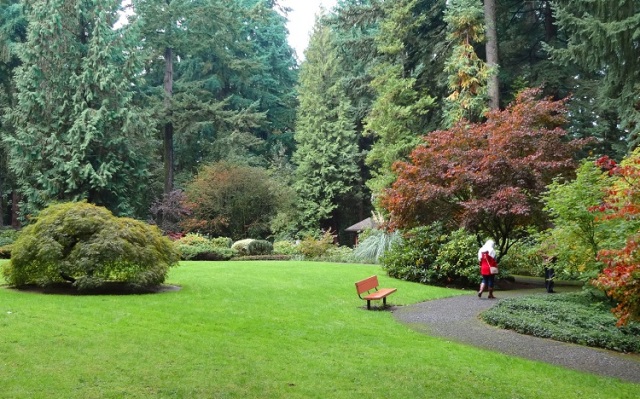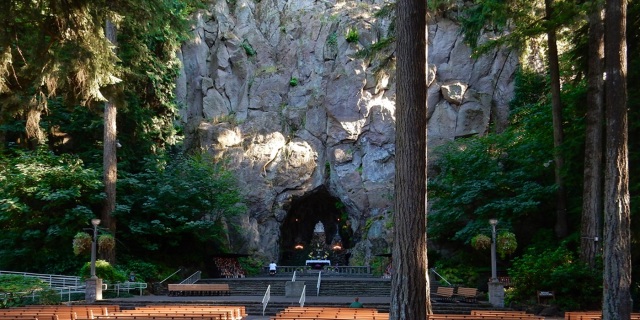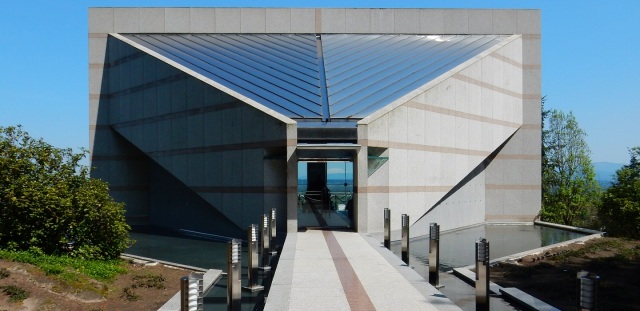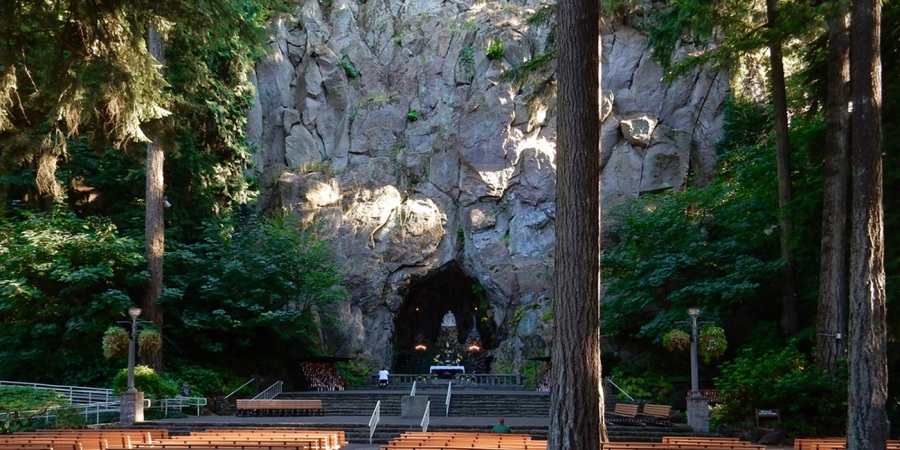Our culture is one of forced dichotomies – hard lines in the sand, either/or, ones and zeros. But as any coder will tell you, ones and zeros weave together a magnificent tapestry of infinite variety. Things exist interdependent of one another, not independent.
The experience of a strong-hearted Pagan and devotional Polytheist going to a Catholic monastic sanctuary is evidence of exactly that. The Grotto is a “National Catholic Shrine dedicated to Mary, Our Sorrowful Mother, which is a ministry of The Servite Friars – Order of Friar Servants of Mary.” As a Goddess-centered Polytheist, I can groove with Mary… so I figured it was worth exploring this shrine.
The very location of The Grotto could be perceived as an impossible contradiction. You approach the gate from two of the busiest roads in Northeast Portland, hotels and apartment buildings looming over you from the hills. Surely this could not be a place of nature. But as you turn into the entrance, you are surrounded by the towering trees and lush greenness that the Pacific Northwest is known for. Here, at the crossroads of a busy intersection, is the gateway to a place of natural beauty.

When you enter the gate, you are first greeted by a statue of Christ on the Cross. Christian iconography still stirs some uncomfortable feelings in my Pagan heart, though I have never been Christian. I’ve done enough interfaith work in my time, and The Grotto says it welcomes peoples of all faiths for peace, serenity, and spiritual inspiration. I welcomed myself and my companions by saying “the Pagans are here!” As we turned into the parking area I felt that transitional veil of space as the sense of this being a sacred place, a place existing within yet outside of the city buzz intensified.
I felt myself wondering if I belonged there, if this space that was created by and for Christians was really for me. But as I looked up at the cliff rising 100 feet above me and watched the trees sway in the breeze, I remembered that no religion – not even ours – can hold dominion over the earth. The earth I was walking on was itself sovereign. I took a moment to tune in more deeply to this place, and felt a sense of curious welcoming, a familiar feeling as I explore my new home – mutually curious beings that we are (I later realized that the sanctuary is on the north side of the same Butte that I live at the western side of). Passing through the gate, I silently offered a blessing of respect and gratitude to this place and to the people that have offered it to the community.

The Plaza level contains the 14 Stations of the Cross, the Chapel of Mary, and one of the most impactful gardens, The Grotto. It is challenging to put into words the intensity here – a 30x30x50 foot manmade cave carved into the cliff. It is a shrine for a replica of Michelangelo’s Pieta, a sculpture that has always moved me. But as I stood in front of the cave, I wasn’t seeing the sculpture. I was seeing rocks that were humming with the love and devotion that had been offered in that space, I was feeling land that had been appreciated and cared for with loving hands and feet, for more than 90 years. Later, walking above the cave, we could all again feel the intense hum of it. Here the contradiction of human’s interference with nature fell away into a beautiful harmony.
As we left the Grotto garden, we made our way to the elevator that brings you to the clifftop level. Here there is much that could be perceived as the dichotomy of “man vs nature” and things really start to get a bit surreal.
So, yes, there is an elevator … outdoors … leading to the top of the cliff. An elevator shaft was built, a freestanding tower of concrete and metal tucked into a curve of the rocks. On the 100 foot ride up to the top of the cliff, you are treated to a very short commentary about the sanctuary as a place to enjoy God’s creation. My companions and I looked at each other with an odd grin, and as we exited the elevator one of them made a comment about it being a little creepy. But the elevator set a mood for what we were about to behold.

The meditation chapel is a feat of design and architecture, perched on the edge of the cliff. It feels a bit like a scene from a 1970’s science fiction film. As you pass through a circular garden, surrounded by trees and plants, you rise a couple of steps and then come upon a long walkway, leading to the edge of the cliff and the uniquely shaped, glass fronted building. On either side of you are pools of water which seem to float in the air around the chapel. Never have I been in a place which so expertly designed a physical and energetic transition. These Christians, they “get it” a little more than we give them credit for. And while the building is a stark contrast to the nature that surrounds it, that contrast only aided a quick energetic shift. Stepping into the chapel was a bit overwhelming, as it feels as if you are suspended in the air and looking out for miles and miles. Some people were sitting, messing with their phones or writing notes, and I wondered if they could sense the same thing I was feeling. My inner voice started rattling again, picking at the slight feeling of uneasiness I was experiencing – forced dichotomies tugging at my brain. One of my companions got up and left the space soon after entering, and I knew that at least with the three of us we were not alone in our experience. Truth be told, I was feeling a bit overwhelmed myself, but sat with it for a while longer.

We wandered the grounds for a while, statues and reliefs of Christian iconography interspersed in expertly designed gardens. Here too, the influence of humanity on nature was obvious, but with respect and harmony. We would stop and look curiously and somewhat awkwardly at the shrines and devotional installations, assessing them from a “how could we do this as polytheists” angle. By the time we reached the labyrinth, I was simultaneously impressed by the place and reflecting on how Christians could do something that felt so Pagan so well, my mind teetering on the rabbit hole of history.
The labyrinth was the common Chartres design, which is not my favorite. But as we approached there was a man standing in the center of it, very obviously enjoying the space and his moment of devotion and prayer. I thought about the commonalities of devotional practice, and how I have sometimes felt I have more in common with radical devotional Catholics than I have with Pagans. We enjoyed the light of the setting sun, and giggled with the trees that seemed so happy and cared for, and ultimately decided not to walk the labyrinth this time.
Our final visit was to the statue of St. Francis, whom we all agreed was one of the saints we could really appreciate. Our intensity lifted as we smiled at the animals that surrounded him and the gentle look on his face.
Thus we made our way back to the circular sitting area near the meditation chapel and elevator, and we all seemed to sink into contemplation. I looked around me at the stunning display of nature, the metal of the elevator shaft, and the polished granite of the meditation chapel. I too felt a bit like an outsider that had harmonized well with this place – someone who did not naturally belong here, but through love and respect had come to find a welcoming place to visit, even if it is not my natural home. There was no either/or, right/wrong here… human influence had not devastated this sanctuary, and my visit as a pagan Polytheist did not have a negative impact either. We could have our moment of harmony, respect the place in which we found ourselves, and then move back into our own spaces, perhaps a little more inspired by what we share.
*all images from The Grotto website, thegrotto.org

